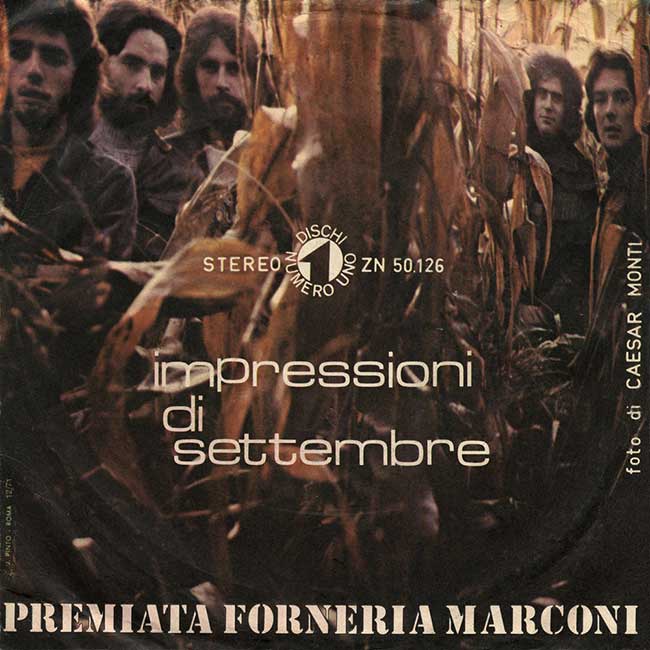Impressioni di Settembre

La carrozza di Hans came out as a 45 rpm, as the flip side of Impressioni di settembre. This piece was composed on the basis of Franco’s fantastic intuition: it was the first song that didn’t have the classic refrain. I correct myself: the refrain, the ritornello – or inciso, as they used to say in the jargon – was there, but was played, not sung. That refrain was so beautiful it seemed to us that we didn’t have the right instrument for it. We tried the flute, but it didn’t have the evocative power. We tried it on the guitar, but it was too normal. We were missing the instrument… but this instrument existed. We discovered it on an Emerson Lake & Palmer album called Lucky Man. It was an instrument with new sounds, similar to those of keyboards and wind instruments. It had a flavour of earth, sky and sea, and of all these things together. It was called the Moog synthesizer, after the name of its inventor, and was made up of three oscillators that created waves to mix together. You could play with the knobs and create your own sound. You could make it brighter, softer, however you wanted: it could sound like a saw, a clarinet, a piccolo… it could sound like many things, but it was nonetheless brazenly synthetic and tremendously beautiful and fascinating because it shook us up. It was the first time we’d heard a synthetic sound and we were thrilled. So, a bit by chance and a bit out of curiosity, we went to an exhibition of musical instruments, where we met the Moog importer, Mr. Monzino. He had only one prototype with him, the second, because until then the only person who had owned and played that wonder was Mr. Keith Emerson, who had received it from Mr.
Moog himself. Just thinking about it, we sighed in despair: it was really an unfair match. So we sat there for a while looking ecstatically at the Moog of our dreams – a portable model – convinced that it was just what we needed, and certain that we couldn’t afford it. But there was no harm in trying. And so we let it rip with the carpe diem.
“How much is it?” I asked Monzino. It cost a fortune and a half. And at the time we didn’t even have the half. Once again, the Abruzzese in me reappeared and said to Monzino: “Look, I think this instrument could really turn Italian music around.”
He looked at me for a long time and then I put on a hard-ass face worthy of the best manager today and kept trying my marketing move (but then I didn’t know it was called marketing). “In my opinion,” I went on, “this instrument could revolutionize all music.”
Then Mr. Monzino’s employee, a certain maestro Fugazza, tried to dissuade me. “Kid, let’s not exaggerate,” he said, “I use it for my musical experiments at the Conservatory of Bologna, but I don’t think this…”
“This thing here,” I insisted, “could have the same boom that the Hammond organ had.”
“Kid, kid… this instrument is a nice prototype but I don’t know… we’ll sell one, maybe two…”
“In my opinion you’ll sell more. On the contrary, let me tell you something: if you give it to us to use for our 45, in my opinion, you’ll sell more than ten.”
Fugazza made a determined face. “We’ll never sell more than ten of them.”
“Want to bet? You do this deal with us here and we use it on the record. Then, if you sell more than ten, you leave it with us, if not… leave it to us anyway and we’ll buy dinner for everyone.”
We had a good laugh and I don’t know how I managed to convince him. I think we softened him up with our desire, our enthusiasm and the name that was starting to circulate. We took the Moog and recorded Impressioni di settembre with its sound. The record came out and it was a wild hit. When, after the words “…ho quasi paura che si perda”, the famous refrain came, everyone was amazed. “What is this?” they said… and in a few days the news was all over Italy.
It was a new sound, a novelty for the senses, a new creation of images and evocations. It gave us an edge (today it would be called a competitive advantage) and made us known as an original, innovative band. A real pop music band. The first in Italy. There was obviously no dinner. The Moog exploded onto the scene in a big way.
Excerpt from: Di Cioccio, Franz, Due volte nella vita, Milan, Mondadori, 1996, pp. 36-38
